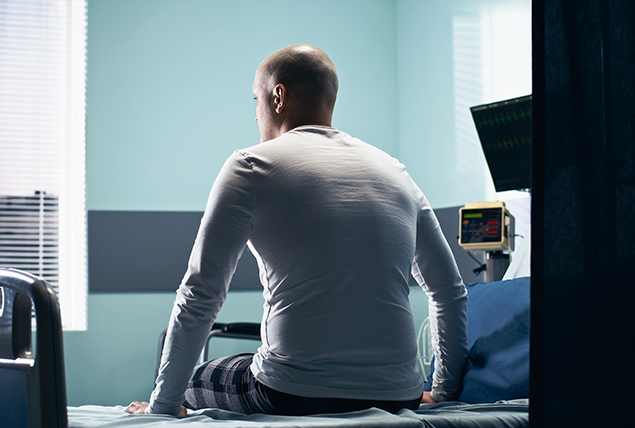HPV-Related Cancers Are Increasing in Men

Cases of oral cancer related to human papillomavirus (HPV) are on the rise in men, continuing a troubling trend that began nearly two decades ago.
Given the current trajectory of the disease in the United States, experts predict the incidence of HPV-related cancer in men, both penile and oral, will surpass that of HPV-related cervical cancer in women in the near future.
One doctor said he has witnessed the primary cause of oral cancers change in the years since he graduated medical school in the mid-1990s.
"When I came here, it was all head and neck cancer caused by smoking and drinking—everyone," said David Goldenberg, M.D., chair of the Department of Otolaryngology-Head and Neck Surgery at Penn State Health and a professor at Penn State College of Medicine. "And over time, it has shifted to where I would say 70 to 80 percent of the patients who walk through the door with this cancer are HPV-induced.
"So in front of our eyes, there has been a shift in the patient population and the disease population," he added. "There's also been a shift in the fact that less people are smoking cigarettes."
Roughly 70 percent of all cases of oropharyngeal cancer—which affects the tonsils, back of the throat and base of the tongue—are caused by strains of HPV, a sexually transmitted infection (STI).
Most HPV infections are asymptomatic, but some strains can cause genital warts. Other strains can cause cancer of the cervix, vagina, vulva and anus, often decades later.
The virus is known to have more than 120 different strains, but HPV 16, in particular, is linked to oral cancer.
Who is at risk?
In short, every sexually active American is at risk of HPV.
Odds are, if you've been sexually active this millennium, you've been exposed to at least one strain, if not more, of the known strains of HPV, America's most common STI.
"Nearly everyone will get HPV at some point in their lives," states the Centers for Disease Control and Prevention (CDC).
More than 42 million Americans have been infected with a type of HPV that causes disease, according to the CDC, and another 13 million Americans will become infected each year.
Still, it is unclear why men are significantly more at risk of developing HPV-related oral cavity and oropharyngeal cancer than their female counterparts.
Generally, women have a 1 in 141 chance of developing oral cancer, while men have about a 1 in 60 chance of being diagnosed in their lifetime, according to the American Cancer Society (ACS).
Some people surmise the difference between the genders' risk levels may have to do with sexual activity.
"Anyone who's had any unprotected sexual contact in their life has been exposed to one, two, five or 10 of these [HPV strains], at least," Goldenberg said. "And, statistically, the more partners you have, the more exposure you have."
Symptoms of HPV-related cancer
By the time HPV-related cancer symptoms make themselves known, decades have typically passed since the patient was initially exposed to HPV. For this reason, and a few others, detecting oropharyngeal cancer early is "elusive," Goldenberg said, adding that the lag time between exposure to HPV and the development of cancer may be 20 to 25 years.
"We catch these [HPV-related oral cancers] relatively late in certain ways because, although the primary tumor often is tiny, it's already spread to the neck by the time we see it," he said. "So the best thing that we can do is prevent it from happening."
Symptoms of oropharyngeal cancer, according to the CDC, may include any of the following:
- Long-lasting sore throat
- Earaches
- Hoarseness
- Swollen lymph nodes
- Pain when swallowing
- Unexplained weight loss
The first sign he often sees in the vast majority of his patients is a painless lump in the neck, Goldenberg said.
"We tell everyone, students and patients, that a lump in the side of the neck in an adult is cancer until proven otherwise," he said.
How is it treated?
Vaccination remains one of the best forms of protection against contracting an HPV-related disease.
Gardasil, the vaccine approved for distribution in the U.S., protects against HPV when received between the ages of 11 and 26 in individuals who have yet to be exposed to the virus.
It is important for patients to complete their HPV vaccination before becoming sexually active, according to John Sfakianos, M.D., an assistant professor of urology and urologic oncology at the Icahn School of Medicine at Mount Sinai in New York City.
"[Even after that,] the most important thing is protective sexual encounters," Sfakianos said.
On the bright side, Goldenberg said the treatment for HPV-related oral cancer has progressively become less invasive in recent years.
"In the olden days, when we had people who were smoking alcoholics or heavy smokers who had head and neck cancer, I think the survival rate was 50-50 overall," he said. "Now I would say the vast majority of people do well and they make it to their five-year mark."
Chemotherapy, surgery and radiation are available to tackle HPV-related oral cancers.
"For those patients who don't do well, we now have emerging immunotherapies that actually attack the viral antigens of the HPV virus," Goldenberg said. "It's very exciting."
Cancer treatment aside, Goldenberg emphasized the fact that Americans have the ability to make HPV-related cancers a thing of the past with a few pricks of a needle.
"We could make this go away if everyone got vaccinated," he said. "If people took the vaccine, within a couple of decades, we could really eradicate this kind of cancer, in my opinion."


















